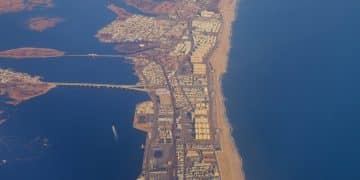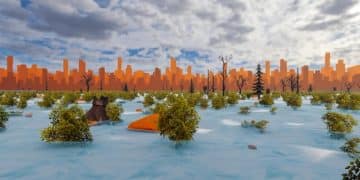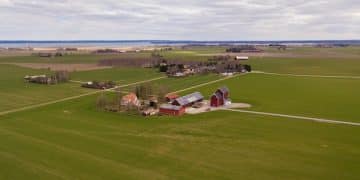How the US Will Adapt to 1 Foot Sea Level Rise by 2040: Strategies & Challenges
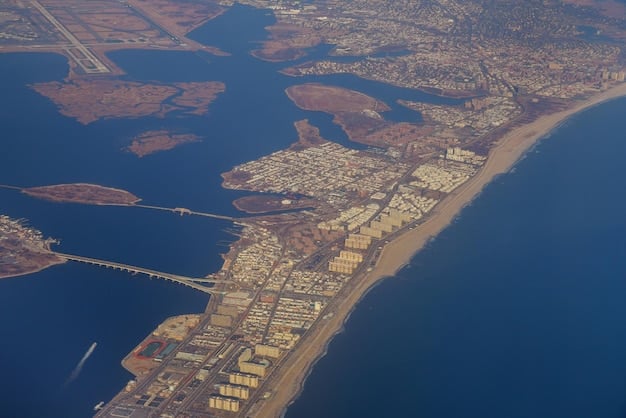
The US is likely to respond to the predicted sea level rise of 1 foot by 2040 through a combination of infrastructure adaptation, policy changes, coastal zone management strategies, and investments in research and technology to mitigate the impacts on vulnerable communities and ecosystems.
The looming threat of rising sea levels is no longer a distant concern but a rapidly approaching reality. The question isn’t if, but how, the **US will respond to the predicted sea level rise of 1 foot by 2040**. The impacts are expected to be far-reaching, affecting coastal communities, infrastructure, and ecosystems.
Understanding the Threat: Sea Level Rise Projections
Sea level rise is a direct consequence of climate change, primarily caused by thermal expansion of water and the melting of glaciers and ice sheets. Understanding the projections is crucial for informed policy and action.
The National Oceanic and Atmospheric Administration (NOAA) and the Intergovernmental Panel on Climate Change (IPCC) provide detailed projections. These projections indicate that a 1-foot rise by 2040 is a realistic scenario, even with moderate emissions reductions. This rise isn’t uniform; some regions of the US will experience greater increases due to factors like land subsidence and ocean currents.
Regional Variations in Sea Level Rise
The impact of sea level rise varies significantly across different regions of the US. The Atlantic coast, for example, is particularly vulnerable due to its low-lying topography and the presence of major coastal cities.
- Atlantic Coast: Cities like Miami, New York, and Boston are already experiencing increased flooding during high tides and storm surges. A 1-foot rise would exacerbate these issues, threatening infrastructure and property.
- Gulf Coast: The Gulf Coast is also highly vulnerable due to its low elevation and soft sediments. Areas like Louisiana are losing land at an alarming rate, and sea level rise will only accelerate this process.
- Pacific Coast: While some parts of the Pacific Coast may experience less rise than the Atlantic, erosion and saltwater intrusion into freshwater sources remain significant concerns.
These regional variations highlight the need for tailored adaptation strategies that address the specific challenges faced by each coastal community.
In summary, sea level rise projections provide a clear warning of the challenges ahead. The US must prepare for and act proactively to mitigate the worst impacts.
Infrastructure Adaptation: Hardening Coastal Defenses
Adapting infrastructure is a crucial aspect of responding to sea level rise. This involves both protecting existing infrastructure and building new infrastructure that is resilient to rising waters.
Coastal communities are exploring a range of strategies, from building seawalls and levees to restoring natural barriers like wetlands and mangroves. Each approach has its own advantages and disadvantages, and the best solution often involves a combination of methods.
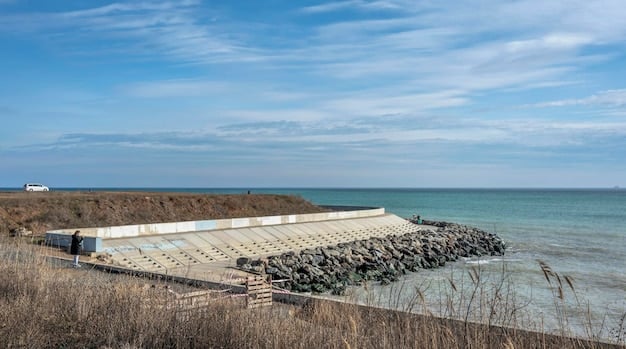
Seawalls and Levees: Traditional Approaches
Seawalls and levees are traditional engineering solutions that have been used for centuries to protect coastal areas. While effective in the short term, they can have negative impacts on coastal ecosystems and may not be sustainable in the long run.
- Advantages: Provide immediate protection to coastal communities and infrastructure.
- Disadvantages: Can disrupt natural sediment transport, leading to erosion in other areas. Can be expensive to build and maintain.
- Sustainability: May not be sustainable in the long term as sea levels continue to rise.
Nature-Based Solutions: Working with Nature
Nature-based solutions, such as restoring wetlands and mangroves, offer a more sustainable approach to coastal defense. These natural barriers can absorb wave energy, reduce erosion, and provide habitat for wildlife.
- Advantages: Provide multiple benefits, including coastal protection, habitat creation, and carbon sequestration.
- Disadvantages: May not be as effective in protecting against extreme storm surges. Require careful planning and management.
- Cost-effectiveness: Can be more cost-effective than traditional engineering solutions in the long run.
In conclusion, infrastructure adaptation is a critical component of the US response to sea level rise. A combination of traditional engineering solutions and nature-based approaches is likely to be most effective.
Policy Changes: Regulatory and Legal Frameworks
Effective policy changes are essential for managing the impacts of sea level rise. These changes involve both regulatory frameworks that govern coastal development and legal mechanisms that address property rights and liability.
Many coastal states and communities are already updating their zoning regulations to restrict development in vulnerable areas. They are also implementing building codes that require new construction to be elevated or otherwise designed to withstand flooding.
Zoning and Land Use Regulations
Zoning and land use regulations play a crucial role in managing coastal development. These regulations can restrict development in vulnerable areas, such as floodplains and wetlands, and can promote more sustainable land use practices.
One example is the implementation of setback requirements, which require new buildings to be set back a certain distance from the shoreline. These setbacks can help to protect buildings from erosion and flooding, and can also provide space for natural coastal habitats.
Building Codes and Design Standards
Building codes and design standards are another important tool for managing the impacts of sea level rise. These codes can require new construction to be elevated or otherwise designed to withstand flooding. They can also promote the use of flood-resistant materials and construction techniques.
For example, the Federal Emergency Management Agency (FEMA) has developed flood maps that identify areas at high risk of flooding. These maps are used to set building codes in many coastal communities, requiring new construction to be elevated above the base flood elevation.
Effective policy changes are crucial for long-term sustainability, ensuring coastal communities are prepared for the challenges of rising sea levels.
Coastal Zone Management: Planning for Retreat
Coastal zone management involves developing comprehensive plans that address the complex challenges of sea level rise. These plans often include strategies for managed retreat, which involves moving development away from the shoreline.
Managed retreat is a controversial but increasingly necessary strategy. It involves purchasing properties in vulnerable areas and either demolishing the buildings or relocating them to safer locations. This approach can be expensive and politically challenging, but it can also be the most effective way to protect lives and property in the long run.
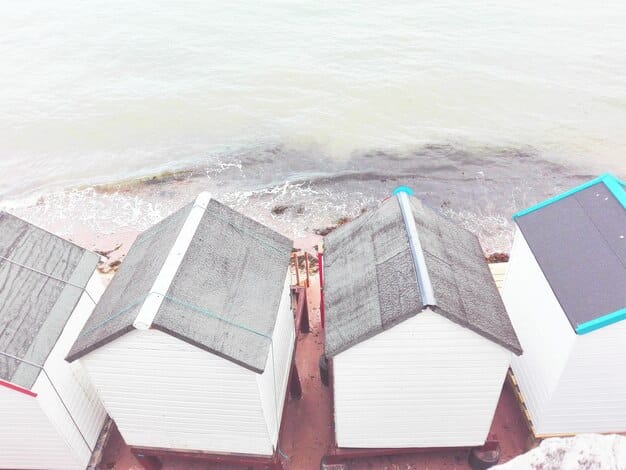
Challenges of Managed Retreat
Managed retreat faces numerous challenges. One of the biggest is the financial cost of purchasing properties and relocating buildings. Another is the political opposition from property owners who may not want to move.
- Financial Costs: Purchasing properties and relocating buildings can be very expensive.
- Political Opposition: Property owners may not want to move, and may resist government efforts to purchase their properties.
- Community Disruption: Managed retreat can disrupt communities, as people are forced to leave their homes and businesses.
Examples of Successful Retreat Strategies
Despite the challenges, there are examples of successful managed retreat strategies in the US. For example, some coastal communities in North Carolina have implemented rolling easements, which require property owners to move their buildings inland as the shoreline erodes.
- Rolling Easements: Require property owners to move their buildings inland as the shoreline erodes.
- Buyouts: Involve the government purchasing properties in vulnerable areas and demolishing the buildings.
- Relocation Assistance: Provide assistance to property owners who want to move their buildings to safer locations.
In conclusion, coastal zone management is a complex but essential part of the US response to sea level rise. Managed retreat, while controversial, may be necessary in some areas to protect lives and property in the long run.
Economic Implications: Costs and Opportunities
The economic implications of sea level rise are significant. The costs include damage to property and infrastructure, loss of economic activity, and increased insurance premiums. However, there are also opportunities for economic growth in areas such as coastal restoration and green technology.
Investing in coastal adaptation can create jobs in construction, engineering, and environmental science. It can also attract tourists who are interested in visiting restored wetlands and other natural areas.
Costs of Inaction
The costs of inaction are high. If the US fails to adequately prepare for sea level rise, it could face trillions of dollars in damages to property and infrastructure. It could also experience significant losses in economic activity, as coastal communities are forced to abandon their homes and businesses.
For instance, the Union of Concerned Scientists estimates that more than $1 trillion in coastal property could be underwater by 2100 if sea levels continue to rise at their current rate.
Investment in Adaptation
Investing in coastal adaptation can generate economic benefits. Coastal restoration projects can create jobs in construction and environmental science, while green technology companies can develop and sell new technologies for managing the impacts of sea level rise.
The American Society of Civil Engineers estimates that every dollar invested in infrastructure generates $3.70 in economic activity.
In summary, sea level rise presents both challenges and opportunities for the US economy. Investing in adaptation can help to mitigate the costs of rising waters and create new opportunities for economic growth.
Research and Technology: Innovations for Resilience
Research and technology play a crucial role in developing innovative solutions for managing the impacts of sea level rise. This includes developing new materials and construction techniques, as well as improving our understanding of coastal processes.
Scientists are working on developing new types of concrete that are more resistant to saltwater corrosion. They are also exploring the use of 3D printing to create artificial reefs that can protect coastlines from erosion.
New Materials and Construction Techniques
New materials and construction techniques can improve the resilience of coastal infrastructure. For example, scientists are developing new types of concrete that are more resistant to saltwater corrosion. They are also exploring the use of 3D printing to create artificial reefs that can protect coastlines from erosion.
Monitoring and Prediction Technologies
Monitoring and prediction technologies can help coastal communities to better understand and prepare for sea level rise. For example, satellites and sensors can be used to monitor sea levels and coastal erosion. Computer models can be used to predict future sea level rise and its impacts on coastal communities.
These technologies can provide valuable data for coastal zone management and adaptation planning, leading to more informed decision-making.
In closing, research and technology are essential for developing innovative solutions that enhance the resilience of coastal communities to sea level rise. These efforts will drive progress in adaptation strategies.
| Key Aspect | Brief Description |
|---|---|
| 🌊 Sea Level Rise | Predicted to rise 1 foot by 2040, impacting coastal areas. |
| 🛡️ Infrastructure | Adaptation involves seawalls, levees, and nature-based solutions. |
| 📜 Policy Changes | Regulations and legal frameworks manage coastal development. |
| 💰 Economic Impact | Costs include property damage; adaptation offers economic opportunities. |
Frequently Asked Questions
▼
The primary cause is thermal expansion of water and the melting of glaciers and ice sheets due to climate change. As the ocean warms, it expands, contributing to higher sea levels.
▼
The Atlantic and Gulf Coasts are most vulnerable due to their low-lying topography. Cities like Miami, New York, and New Orleans face significant threats from rising sea levels.
▼
Nature-based solutions include restoring wetlands and mangroves. These natural barriers absorb wave energy, reduce erosion, and provide habitats, offering sustainable coastal protection.
▼
Managed retreat involves moving development away from the shoreline. It’s controversial due to high costs, political opposition from property owners, and community disruption from relocations.
▼
Research and technology develop new materials, improve construction techniques, and enhance monitoring and prediction. These innovations lead to more resilient coastal infrastructure and informed adaptation strategies.
Conclusion
Addressing the predicted sea level rise of 1 foot by 2040 requires a multi-faceted approach from the US, encompassing infrastructure adaptation, policy changes, coastal zone management, economic investment, and technological innovation. Proactive and integrated strategies are essential for mitigating the impacts on vulnerable communities and ecosystems.

